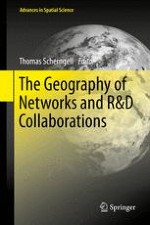2013 | OriginalPaper | Chapter
3. Recent Developments of Complex Network Analysis in Spatial Planning
Authors : Andrea De Montis, Simone Caschili, Alessandro Chessa
Published in: The Geography of Networks and R&D Collaborations
Publisher: Springer International Publishing
Activate our intelligent search to find suitable subject content or patents.
Select sections of text to find matching patents with Artificial Intelligence. powered by
Select sections of text to find additional relevant content using AI-assisted search. powered by
